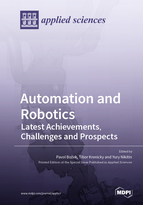Automation and Robotics: Latest Achievements, Challenges and Prospects
A special issue of Applied Sciences (ISSN 2076-3417). This special issue belongs to the section "Robotics and Automation".
Deadline for manuscript submissions: closed (20 August 2021) | Viewed by 52383
Special Issue Editors
Interests: robot technology; automation; production technology; navigation systems; control algorithms for manipulators and mobile robots; sensors for robot state sensing; part handling; navigation; sensors; machine vision
Special Issues, Collections and Topics in MDPI journals
Interests: technical diagnostics; virtual instrumentation; mechanical engineering; nanomaterials
Special Issues, Collections and Topics in MDPI journals
Interests: mechatronic systems diagnosis; mechatronics; automation and robotics
Special Issues, Collections and Topics in MDPI journals
Special Issue Information
Dear Colleagues,
Automation, supported by robotics, is currently one of the necessary elements that can effectively speed up and improve production. The industrialization of complex mechatronic components, especially robots, requires a large number of special processes already in the pre-production stage by modelling and simulation. This area of scientific research from the very beginning includes drives, process technology, actuators, sensors, control systems and all connections in mechatronic systems.
Automation and robotics form broad-spectrum areas of research, which are tightly interconnected. To reduce costs in the pre-production stage and to reduce production preparation time, it is necessary to solve complex tasks in the form of simulation with the use of standard software products and new technologies that allow, for example, machine vision, holography and other imaging tools to examine new physical contexts, dependencies and connections. Therefore, I call on researchers and scientists who work on topics related to automation and robotics to contribute and offer the results of their works for professional publication. I call for the presentations of original results achieved using the latest methodologies for the production and implementation of new generation drives, flexible actuators, actuators with new control principles and those based on navigation systems. All those who work with new approaches in the design of these parts and components for automated and robotic movements are welcome to join the call for the development of these systems and new applications for future generations.
This Special Issue welcomes the latest achievements, challenges and prospects for drives, actuators, sensors, controls, robot navigation with reverse validation and applications in the field of industrial automation and robotics. Its aim is to present contributions to shorten pre-production processes and simulate and design key elements and components, while achieving exceptional quality and minimizing costs.
Contributions should focus primarily on:
- New approaches to the modelling and simulation of sensors and monitoring and control systems in automated systems;
- Progressive methods of robot machine learning development;
- Optimization approaches and learning control methods for robotics and automation;
- Sensors in mobile robotics and manipulators (sensing the condition of robots, sensors for manipulating the parts, navigation sensors, machine vision sensors, etc.);
- Actuators for robotic systems;
- Navigation of mobile robots;
- New fault detection and diagnostic solutions for robotics;
- Progressive applications of robotics and automation for practice.
Prof. Dr. Pavol Božek
Dr. Tibor Krenicky
Dr. Yury Nikitin
Guest Editors
Manuscript Submission Information
Manuscripts should be submitted online at www.mdpi.com by registering and logging in to this website. Once you are registered, click here to go to the submission form. Manuscripts can be submitted until the deadline. All submissions that pass pre-check are peer-reviewed. Accepted papers will be published continuously in the journal (as soon as accepted) and will be listed together on the special issue website. Research articles, review articles as well as short communications are invited. For planned papers, a title and short abstract (about 100 words) can be sent to the Editorial Office for announcement on this website.
Submitted manuscripts should not have been published previously, nor be under consideration for publication elsewhere (except conference proceedings papers). All manuscripts are thoroughly refereed through a single-blind peer-review process. A guide for authors and other relevant information for submission of manuscripts is available on the Instructions for Authors page. Applied Sciences is an international peer-reviewed open access semimonthly journal published by MDPI.
Please visit the Instructions for Authors page before submitting a manuscript. The Article Processing Charge (APC) for publication in this open access journal is 2400 CHF (Swiss Francs). Submitted papers should be well formatted and use good English. Authors may use MDPI's English editing service prior to publication or during author revisions.
Keywords
- automation
- robotics
- drives
- actuators
- sensors
- diagnostics
- holography
- simulation
- virtual instrumentation
- control systems
- robot navigation
- reverse validation
- trajectory control








